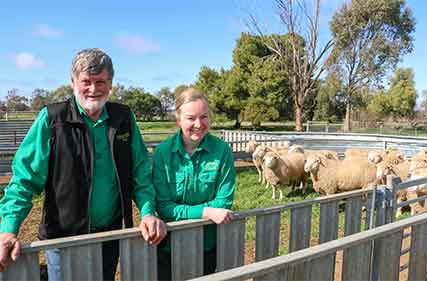
Roger Trewick and daughter-in-law Tara Gibbons with 2023 drop Poll Dorset rams at Pepperton stud, Elmore. Image Kim Woods
Thirty years of stud breeding along high performance lines will go under the hammer with the stage one dispersal of autumn lambing ewes from the central Victorian Pepperton flock on October 16.
Fifth generation farmer Roger Trewick and his wife Dianne, Pepperton Poll Dorsets and White Suffolks, Elmore, run 400 stud ewes, achieving an 82 per cent conception rate to AI this year.
The stud will be holding a stage one dispersal of autumn lambing ewes in conjunction with the 2024 on-property ram sale, starting at 11am, followed by the second stage dispersal of spring lambing ewes in February 2025.
Pepperton will also offer 50 Poll Dorset and 50 White Suffolk top indexing 2023 drop rams at 11am on October 16, interfaced with AuctionsPlus.
There will be 155 Poll Dorset and 105 White Suffolk ewes available, all July shorn, drenched, vaccinated and accredited.
“We are firm believers in quality over quantity and in order to produce the best rams, we believe you need to start with the best ewes,” Dianne said.
“To begin with, our stud ewes mostly have a minimum of 150 TCP (terminal carcase production) before their physical attributes are thoroughly screened.
“This high threshold for what we accept in our stud has resulted in an even spread of high-quality ewes that dependably produce some of the best rams in the breed, year after year.”
The Poll Dorset stud ewes have been sired by Pepperton, Illfracombe, Felix, Jewsharp, Woolumbool, Melton Vale, Bruan, Linton and Derrynock rams.
The White Suffolk stud ewes carry Pepperton, Ashmore, Farrer, Bundara Downs, Felix, and Ella Matta blood lines.
With the industry shift to lamb brands focused on eating quality, the stud is trending well above breed average for intramuscular fat, shearforce (tenderness), muscle and weaning weight.
Roger and Dianne have been breeding Poll Dorsets under their prefix Pepperton since 1994 and were early adopters of LAMBPLAN performance recording, concentrating on growth, muscling, and moderate fat levels.
Adding White Suffolks in 2004, Pepperton produces each year around 200 rams grazed on dryland lucerne with minimal grain feeding during dry times.
Data is collected by seven months of age on all rams, and they consistently test high for muscling and growth with moderate fat and lower birthweights.
“The heavy focus on genetics has been instrumental in producing rams with traits the market is demanding such as high muscling, fast growth and low to moderate birth weight,” Dianne said.
“The top index ram lambs from each of the sires used in the AI program are DNA tested for intramuscular fat, shearforce, lean meat yield and dressing percentage resulting in excellent lamb eating quality indexes.”
In recent years Pepperton has made consistent genetic advancements towards improving the key profit drivers for their Poll Dorset and White Suffolk rams.
Post weaning weight and post weaning eye muscle depth are both trending above the breed average and Australian Sheep Breeding Values analysis target.
Pepperton began DNA testing rams for IMF in 2017 and sources leading industry sires for the trait to increase marbling and eating quality in carcases.
During the past decade shearforce has also been rapidly decreasing and lamb eating quality increasing resulting in more tender lamb cuts and a better consumer eating experience.
